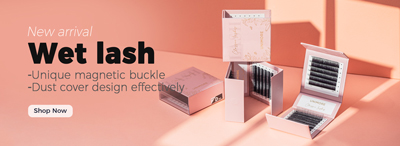Eye infections can occur when germs are introduced to the eye or the surrounding area. As a lash practitioner, you must educate your clients on the need for hygiene to keep their lovely eyes free of infection.
If your client shows any of the symptoms of an eyelash extension infection, we advise that you not proceed with the procedure until the client has been treated by a healthcare practitioner and the symptoms have reduced.
However, you must use your best judgment. When the symptoms can not be passed on to another person (like allergic conjunctivitis), it’s sometimes okay to proceed with written clearance from a healthcare expert, A note from a doctor is preferable.
Importance Of Identifying And Reducing The Risk Of Eyelash Extension Infection
You may come across various types of eye infections with your clients. It’s important to understand the differences and when it’s safe to continue with your service. This will enable you not to worsen the infection, or prevent the spread of infections that can cause blindness or other diseases.
Eyelash Infections to look out for include:
1. Allergic Conjunctivitis: Eyes become watery, red, and itchy when they are exposed to provoking substances such as pet dander, pollen, dust, mold, and so on. This is the most common infection among clients, and it can be difficult to treat. Allergies and allergic reactions cannot infect someone, and therefore cannot be transmitted from one client to another, however, putting lash extensions to already sensitive eyes might worsen the symptoms slightly, if not completely.
2. Conjunctivitis: Conjunctivitis is an eye infection that causes the conjunctiva of the eye to become inflamed, turning the eye pink or red in some cases. This dangerous condition, sometimes known as Pinkeye, is easily transmitted. Do not continue with the service until the client has been treated and all symptoms have disappeared. This will help to prevent the worsening of the symptoms and also the spreading of the infection.
3. Blepharitis: Blepharitis is the inflammation and redness of the lash follicles. Bad hygiene, allergies, mites, dandruff, and certain drugs can all contribute to this. We advise that you maintain proper hygiene in your saloon and with your equipment, to prevent your clients from being infected with Blepharitis. Also, do not continue with the service if the client already has this eyelash extension infection because the reaction/symptoms will most likely develop.
4. Demodex: Infection and inflammation can be caused by parasites located inside pores and hair follicles. They are called Eye mites. Mites live inside pores and might be difficult to detect. If your eyes are irritated or inflamed in any way, it could be Demodex, and we don’t advocate getting lash extensions in these cases.
5. Stye: Stye is a bacterial infection of the sebaceous glands that causes a red, uncomfortable lump or inflamed area around the eye. When the hair follicle becomes clogged and inflamed, styes can develop. Styes, while not contagious, require hot compresses to clear them. We recommend not proceeding with the service until the stye has gone away.

Tips To Help Your Clients Avoid Or Lower Their Risk Of Eyelash Extension Infections
1. Encourage your customers to clean their eyelids every night: Tell them to wipe their eyelashes by following the steps below.
Step 1: Using a cleansing brush, they should apply a half pump of foamy cleanser.
Step 2: Keep eyelids shut. Use the brush to wash the entire upper eyelid with the eyelid foaming cleanser in 5-10 strong strokes back and forth. Make sure to get the eyelid margin because here is where bacteria and Demodex accumulate. If you get the foaming cleanser in your eye, it will sting because it is a soap.
Step 3: Rinse the brush under lukewarm tap water and wipe any excess water with a towel.
Step 4: Use the brush to rinse away any soapy residue with 2-5 gentle back and forth strokes. Steps 3 and 4 should be repeated until all soapy residue is gone. Keep in mind that you’re cleaning the outsides of your eyes, not the insides.
2. Advice your clients on their choice of Eye makeup: When your clients have eyelash extensions, always warn them not to apply any waterproof eye makeup because waterproof eye makeup is difficult to remove without an oil-based eye makeup remover. This might loosen the attachment site and cause your extension to fall out prematurely. Water-based primers, eye shadows, and eyeliners are recommended. Finally, when you have extensions on, there is no need to put on mascara because your lashes are already long and look beautiful.
3. Do thorough inspection during a deep clean: Always inspect your client’s eyelids under magnification for signs of infection whenever they return for a refill. Check for blepharitis symptoms, which can be caused by bacteria, Demodex, or both. A Demodex mite infestation is indicated by the waxy, cylindrical shape of the eyelid debris. Remove all the remaining extensions and do a complete cleaning if there are any signs of blepharitis. This should be done until the eyelids are completely clean, and then a brand-new, clean extension set should be fitted. Although this is more expensive than a refill, it is more inconvenient than having red-eye.
4. Clean your equipment well before applying it to clients’ eyes: Remove any visible dirt as well as any disposable components. Use soap and water or a cleaning chemical to clean surfaces. After washing, thoroughly rinse the equipment and completely dry it before disinfecting it.

5. Advice a client suspected or confirmed to have an eye infection to see an optometrist: If your client suffers an infection from eyelash extensions, have him or she see an eye doctor. Eyelid infections must not be overlooked. An infection of the eyelid can progress to periorbital cellulitis, which requires the use of oral antibiohands to prevent the infection from spreading to the eye, sinus cavity, and, in rare circumstances, the brain.
6. Tell your clients not to brush their lashes when they are damp. The extensions and adhesive are already weighing down the natural lashes. Brushing with more water weight causes early lash shedding in hairs with decreasing follicles or those in the resting period. A new lash can take up to two months to grow back, depending on the phase it was in when it was removed. To remove extra water, they should dab their lashes with a smooth sponge, towel, paper towel, or rag. As they dry, they will fan out again. They should not dry them with hot air from their blow dryer because the heat can singe the fan tips. It’s all right with the cool shot! (If the face is directly over it, opening an oven rapidly or steam from boiling water can also singe the tips.)
7. Encourage your client to avoid picking, pulling, or rubbing their extensions. It is not recommended that they sleep on their stomachs. If they sleep on their side, they should keep their pillow tucked away from their eyes. Friction and weight weaken their connections, causing them to break off prematurely. Extensions do not fall out unless something weakens their adhesion or not enough glue is applied during application (in that case, it will fall off right away and not over time)
8. They should not show up to your fills with eye or lash makeup on. Because when dirty lashes interfere with the adhesive’s ability to attach to the natural lash, you won’t receive a long-lasting fill. Primer is used to open the hair’s cuticle for a firmer connection. It’s not a makeup remover, and it won’t work if there is any left. The under-eye pads and tape will not stay on your clients’ skin if they have thick makeup under and on their eyes. When they slip, creating redness and pain, they will cause major discomfort and possibly a scratched sclera (the white of the eye).
9. Instruct them to close their eyes completely during fills and avoid excessive eye and head movement! When your clients continuously move their eyes, a single lash will be difficult to isolate, which significantly reduces the number of lashes you can stretch. Furthermore, an open seal allows adhesive fumes to pass through. Their eyes will burn and/or water, making it impossible to isolate and prolong anything until they are dry. Chemical burns and scrapes from the tape movement hurt and are red for several days after.

CONCLUSION
It is your responsibility as a professional eyelash extension artist to keep your station, instruments, and hands free of bacteria that could spread infection or disease. Always avoid applying lash extensions to clients who have symptoms of these illnesses. To protect yourself, we urge that all new clients sign a waiver and release form. This form is critical to your lash business as it is a type of insurance that can protect you from potential liabilities. It is always preferable to be safe than sorry! Go out into the world and enjoy making beautiful eyelash extensions for your clients now that you know to stay healthy.







